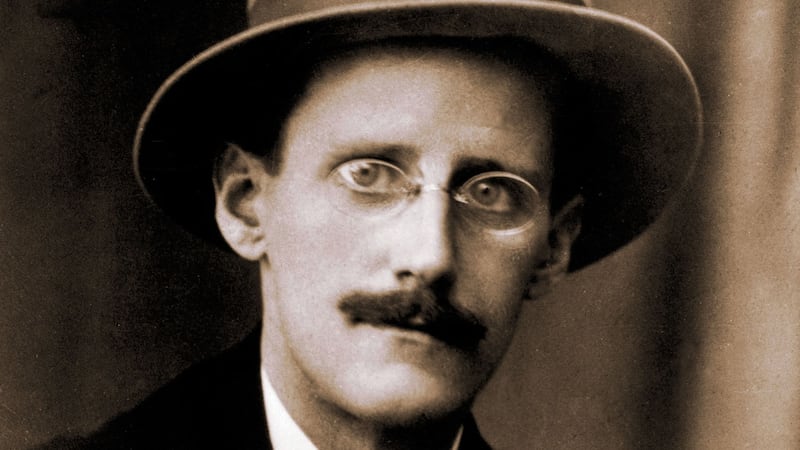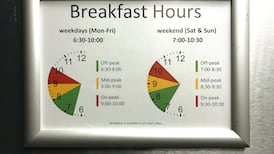Early on Sunday morning I was standing on the Via Cavana in Trieste having my photograph taken for Il Piccolo della Sera. This is of no earthly interest to anyone except that Il Piccolo della Sera was the newspaper for which James Joyce wrote, in perfect Italian of course, his most extensive incursions into journalism.
They were, for the most part, explanations of contemporary Irish politics and replies to the misrepresentations of the English press. I have always thought it a little odd that the most important commentaries on Irish affairs by arguably the most important Irish writer appeared in the local paper of a provincial Austro-Hungarian port city. But when you’re actually in Trieste and when the same newspaper wants to talk to you about Brexit, it doesn’t seem odd at all. It just seems European.
One of the things we are experiencing at the moment is a gulf of comprehension between large parts of the English establishment (the Brexity parts) and Ireland.
It has many facets, but one of them has to do with a difference in cultural genealogy. Most of the great works of modern English literature and art were created in England or, at very least, within the empire. But on the other hand, it is very hard to think of modern Irish literature and art without thinking of continental Europe.
While Ireland and England are much more alike than we Irish like to admit, there is a gulf between us when it comes to attitudes to Europe
John Synge and WB Yeats, the great collaborators (with Augusta Gregory) in the creation of the Abbey, didn’t meet in Sligo or on the Aran Islands – they met in Paris. So did Joyce and Samuel Beckett. Most of Eileen Grey’s great design work was done in France. Kate O’Brien really became a writer in Spain, as did Colm Toibín. And so on.
When Joyce and Nora Barnacle left Dublin in 1904, they didn’t go to London or New York. They made their way to Trieste, where on their very first night, Joyce got himself arrested after being caught up in a brawl with English sailors.
Frontier city
Even today, it is a frontier city, on the edges of three countries – Italy, Slovenia and Croatia. But in the years that Joyce lived there (most of the period between 1904 and 1915 and again briefly in 1919 and 1920), Trieste was even more multicultural – Italian, Austrian, Slavic, Jewish, Greek.

Joyce was close to the Jewish community – his great friend, the writer Italo Svevo became one of the models for Leopold Bloom. He taught English to wealthy Greek merchants and attended services in the beautiful Greek Orthodox (now Serbian Orthodox) church of San Nicolò. He feasted on this stew of languages and cultures.
It is, for all sorts of reasons, impossible to imagine the great anatomies of early 20th century London being produced in such a place. But when we think of Dubliners, with its minute etching of the physical and mental topography of the city, we have to remind ourselves that most of its was written, not in our capital, but in a second floor flat in Via San Nicolò.
It was on the third floor of a house in Via Nuova that Joyce rewrote Stephen Hero as A Portrait of the Artist as a Young Man. In a second floor room on Via Donato Bramante, he began work on perhaps the greatest of all Irish artistic achievements, Ulysses.
Joyce is inscribed on this city but it is also inscribed on his Dublin – it was Trieste that gave Joyce the sheer cosmopolitan energy that he infused back into the native city he had left in disgust, making it not the dull provincial nowhere he had fled but, in his re-imagining, a European metropolis.
Explain Brexit to Italians
I’ve been vaguely aware of all of this ever since I first read Joyce as a teenager, but it is particularly striking to encounter it physically while at the same time trying to explain Brexit to Italians.
It brings home the fact that, while Ireland and England are much more alike than we Irish like to admit, there is a gulf between us when it comes to attitudes to Europe.
Being European gave us relief and release from being too much enclosed in our own company and thus allowed us to get over ourselves
Some of it has to do with political history – English nationalism defined itself in part against France; Irish nationalism looked first to Spain and then to France as places of refuge and sources of salvation. (Germany, too, in 1916 and – for the fanatics of the IRA – in the years of the second World War, but we don’t like to talk about that.) Some of it is religious – its Protestantism divided England from Catholic Europe; Irish Catholicism felt, of course, part of it.
Dreary tribal identities
But some of it goes beyond those dreary tribal identities. Perhaps, being obviously small, Ireland could find in the expansiveness of the Continent a relief from claustrophobia. And paradoxically, in that release lay the possibility of looking back on Ireland itself, as Joyce did so wonderfully, without rancour but with a good-humoured forgiveness.
What he did in the early years of the 20th century, his country men and women did after EU membership in 1973 – being European gave us relief and release from being too much enclosed in our own company and thus allowed us to get over ourselves.
That, sadly, has not been quite the case for our nearest neighbours.










